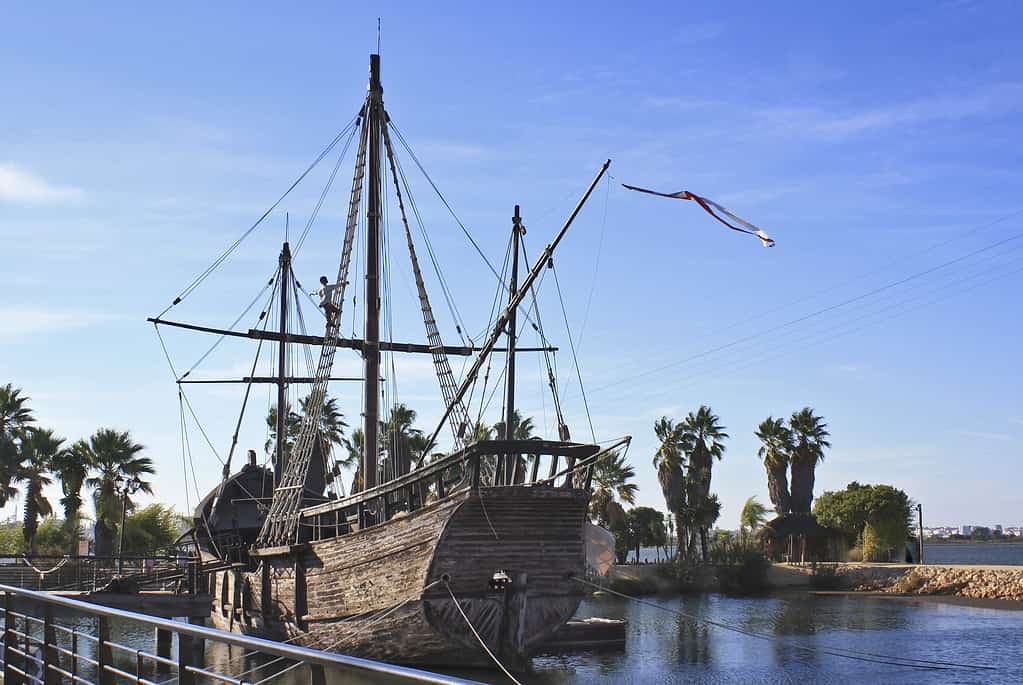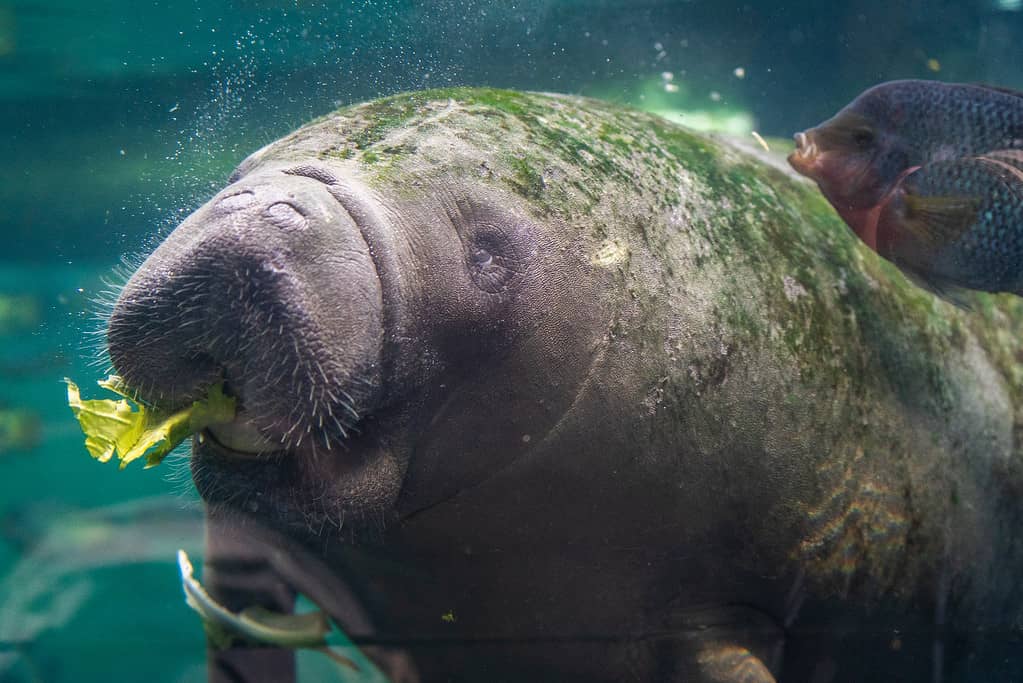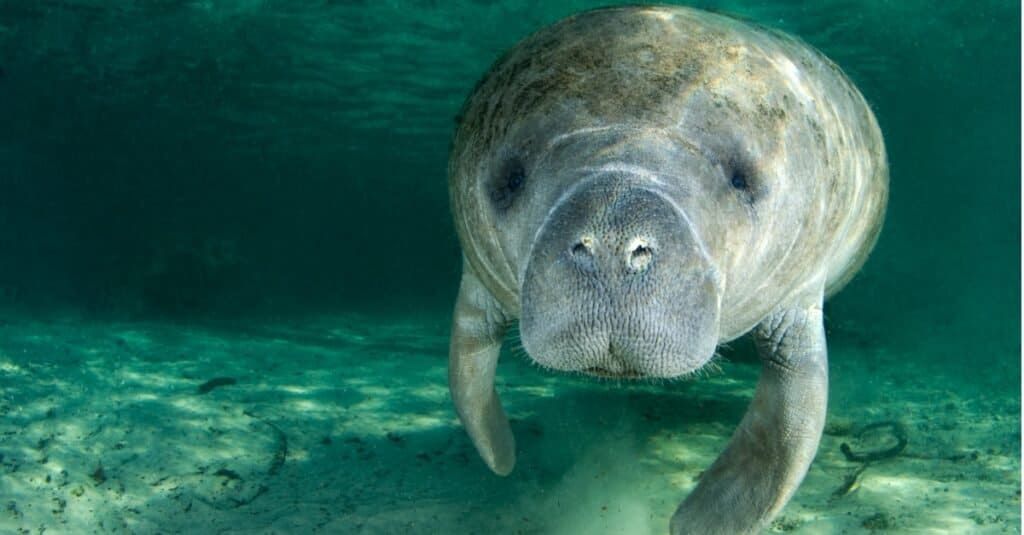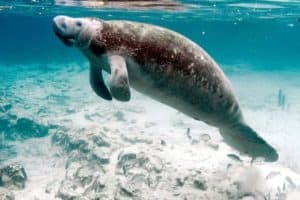Christopher Columbus embarked on his second voyage from Spain in 1493. He brought with him 17 ships and 1,200 people with plans to explore and settle the “New World.” Sailing past what today is known as the Dominican Republic, Columbus reported sighting three mermaids. However, these mermaids didn’t fit the description Columbus had heard of as a beautiful maiden with the tail of a fish. In fact, Columbus described these “mermaids” as “not so beautiful as they are said to be, for their faces had some masculine traits.”
What sea creature did Columbus really see swimming in the water? Read on to find out.
Why Historians Believe Christopher Columbus Mistook Manatees for Mermaids

Christopher Columbus claimed to have seen three mermaids swimming in the water near the Dominican Republic.
©McXas/iStock via Getty Images
When Columbus was voyaging in the 15th century, the ocean was still relatively unknown and mysterious. Myths and legends were prominent at the time to help explain the remote and unexplored seas. Columbus would have been familiar with the myth of a mermaid, a sea creature with the upper body of a beautiful woman and the lower body of a fish. However, he would never have seen nor heard of manatees or dugongs.
Today, most people know manatees are slow-moving marine mammals that can weigh well over 1,000 pounds. However, in the past, a sighting of a manatee slowly swimming by a ship caused curious sailors to speculate about what they were seeing.
What Are Manatees?

Manatees are aquatic herbivores that swim peacefully in warm and shallow waters.
©Harry Collins Photography/Shutterstock.com
There are four species in the order Sirenea. Sirenea is derived from the Greek word for sirens, another type of mythical mermaid creature. Three species of manatees can be found around the Atlantic Ocean. The fourth is called the dugong, and it lives in the Indo-Pacific.
Manatees live in slow-moving rivers, canals, bays, coastal waters, and estuaries. They spend their days eating, resting, and investigating their surroundings.
Manatee or Mermaid?

Although it may seem strange, many sailors in the past have mistaken manatees for mermaids.
©Stanislav Hubkin/iStock via Getty Images
Manatees, also known as sea cows, are gentle gray sea mammals that can weigh 800 to 1,200 pounds. Nonterritorial and nonaggressive, they live in warm coastal waters and rivers and swim very slowly. So how could a sailor mistake a stout sea mammal for a mermaid?
For one thing, manatees breathe air and rise to the surface to take breaths. They also can rise upright out of the water in what is called a tail stand. Manatees can even turn their heads, despite having no necks. And they have two forelimbs that look a lot more like hands than flippers. They even have finger-like bones with fingernails. As they swim through the water, their large, paddle-shaped tail helps propel them along. Perhaps we can see how a tired and sea-weary sailor with mermaids on his mind could mistake a manatee for a mermaid.
Mermaid Sightings Date Back to Ancient Babylon
Columbus wasn’t the first person to have reported seeing a mythical creature in the sea. Most likely inspired by the dugong, which is in the order Sirenia, along with the manatee, the ancient Babylonians had a god with the features of both humans and fish.
European ocean maps showed drawings of mermaids in places where manatees were abundant. Explorer John Smith may have seen a manatee, which he thought was a mermaid, while in the Caribbean in 1614. Smith claimed the mermaid had green hair. The “mermaid’s” green hair may have been green algae, which can grow on manatees.

Green algae growing on a manatee may have been mistaken for green hair by explorer, John Smith.
©Wirestock/iStock via Getty Images
And finally, even the fearsome pirate, Blackbeard, was said to have seen mermaids. Deeply afraid of the mythological creatures, Blackbeard avoided all areas where they had been spotted. Could it have been the gentle manatee that caused so many reports of mermaid sightings?
Why Manatees Need Protection Today

Manatees are suffering from a lack of seagrass, their main food source.
©A Cotton Photo/Shutterstock.com
Once considered an endangered species, the threat was downlisted from endangered to threatened in 2017. However, the manatee may once again be on the endangered list very soon. In the past three years, over 2,500 manatees have died in Florida, mainly due to lack of food. The manatee’s main source of diet is seagrass, which has experienced extreme loss due to pollution, algae blooms, and other issues.
The U.S. Fish and Wildlife officials are currently reviewing whether manatees should go back on the endangered list. Officials have started a hand-feeding program, giving Florida manatees Romaine lettuce, to help make up for a massive loss of seagrass.
In addition to losing their main source of food, manatees are vulnerable to injuries from boats and fishing nets. The manatees swim so slowly, that it’s hard for them to escape threats.
The photo featured at the top of this post is © Thierry Eidenweil/Shutterstock.com
Thank you for reading! Have some feedback for us? Contact the AZ Animals editorial team.






